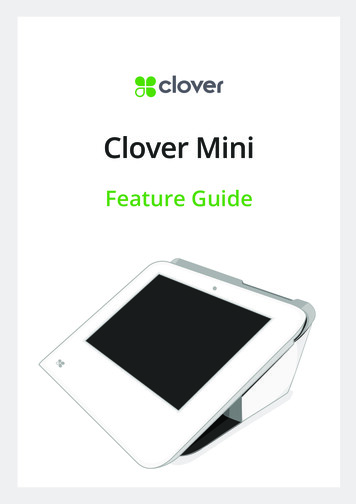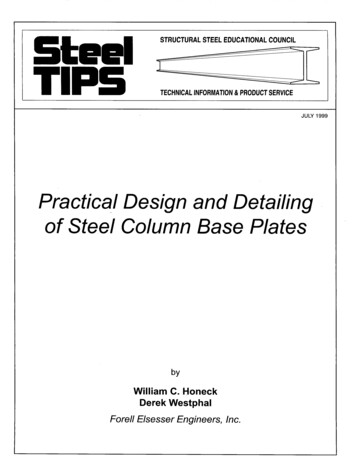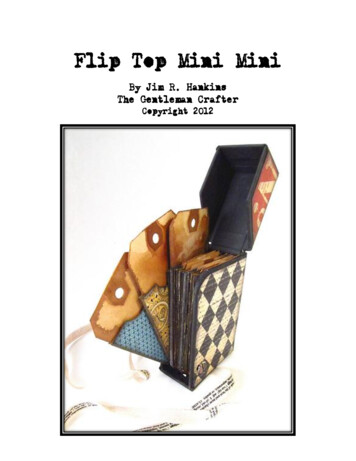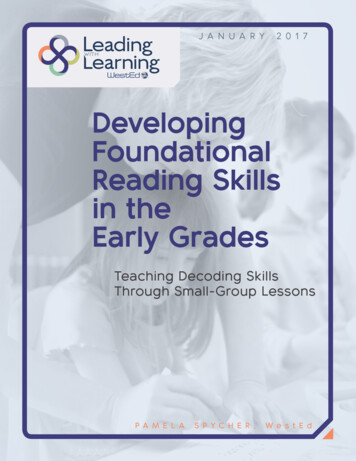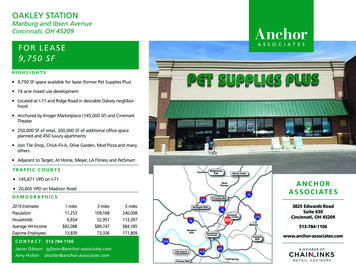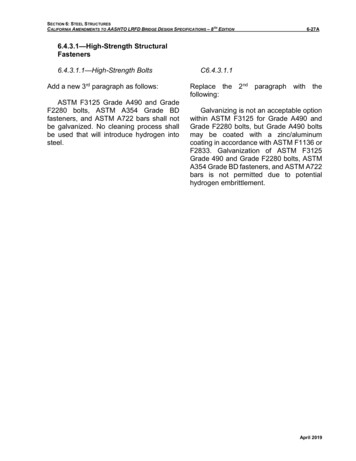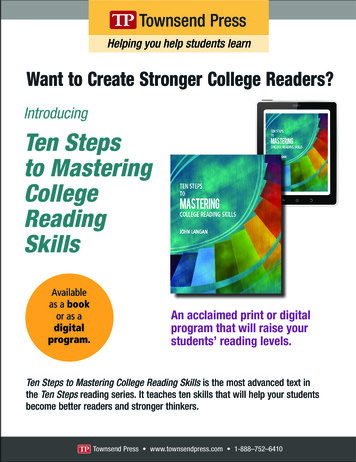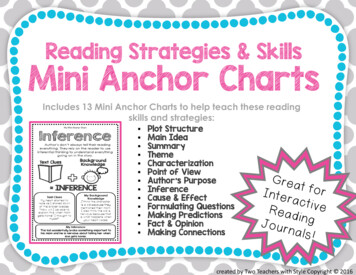
Transcription
Reading Strategies & SkillsMini Anchor ChartsIncludes 13 Mini Anchor Charts to help teach these readingskills and strategies: Plot StructureMain IdeaSummaryThemeCharacterizationPoint of ViewAuthor’s PurposeInferenceCause & EffectFormulating QuestionsMaking PredictionsFact & OpinionMaking Connectionscreated by Two Teachers with Style Copyright 2016
Teacher Tips Give your students these mini anchor charts to glue in their readingjournals to remember some of the different components of readingcomprehension. I suggest making each student a copy and as you introduce eachcomprehension component, your students can add a mini anchorchart to their reading journal. Consider spending a few days discussing each comprehensioncomponent before introducing the next one. Encourage students to go back in their journals to reference the minianchor charts if they are confused about the comprehensioncomponents and the role they play in their independent reading.created by Two Teachers with Style Copyright 2015
My Mini Anchor ChartPlot StructurePlot what happens in a story.Structure the way the story is writtenAll stories tend follow the same plot structure.This structure is sometimes known as a storymountain.My Mini Anchor ChartPlot StructurePlot what happens in a story.Structure the way the story is writtenAll stories tend follow the same plot structure.This structure is sometimes known as a e hook is the introduction. This is where theauthor will introduce the characters and settingof the story.HookThe hook is the introduction. This is where theauthor will introduce the characters and settingof the story.ProblemThe problem or conflict is what the story willmostly be about. The author usually introducesthe problem early in the story.ProblemThe problem or conflict is what the story willmostly be about. The author usually introducesthe problem early in the story.RisingActionThe rising action are the 2-3 events that helpthe reader understand the problem or conflictgoing on in the story.RisingActionThe rising action are the 2-3 events that helpthe reader understand the problem or conflictgoing on in the story.ClimaxThe climax is the most exciting part of the story.It is usually the big event that you won’t forget.ClimaxThe climax is the most exciting part of the story.It is usually the big event that you won’t forget.FallingActionThe falling action are the 1-2 events that happenafter the climax. These events lead up to thesolution of the problem.FallingActionThe falling action are the 1-2 events that happenafter the climax. These events lead up to thesolution of the problem.ResolutionThe resolution usually happens at the end. Thisis where the main problem or conflict getssolved.ResolutionThe resolution usually happens at the end. Thisis where the main problem or conflict getssolved.created by Two Teachers with Style Copyright 2016
My Mini Anchor ChartPlot StructurePlot what happens in a story.Structure the way the story is writtenAll stories tend follow the same plot structure.This structure is sometimes known as a storymountain.My Mini Anchor ChartPlot StructurePlot what happens in a story.Structure the way the story is writtenAll stories tend follow the same plot structure.This structure is sometimes known as a eated by Two Teachers with Style Copyright 2016
Main IdeaThe Main Idea is what the entire text is mostlyabout. The details included in the text willconnect back to the main idea.Main idea:Ice cream is the best summer treat.You can: Write the main idea in 1-2 sentences. Write a main idea for an entire text, aparagraph, or a chapter. Write the main idea for non-fiction orfictional textsSupporting Detail:Ice cream is cold, and it refreshes youon a hot summer day.Supporting Detail:There are so many different types ofice cream, everyone can find a treatthey enjoy.Supporting Detail:You can eat ice cream on a stick or ina cone, so it is a really easy treat totake with you on a busy summer day.My Mini Anchor ChartMain IdeaThe Main Idea is what the entire text is mostlyabout. The details included in the text willconnect back to the main idea.You can: Write the main idea in 1-2 sentences. Write a main idea for an entire text, aparagraph, or a chapter. Write the main idea for non-fiction orfictional textsMain idea:Ice cream is the best summer treat.My Mini Anchor ChartSupporting Detail:Ice cream is cold, and it refreshes youon a hot summer day.Supporting Detail:There are so many different types ofice cream, everyone can find a treatthey enjoy.Supporting Detail:You can eat ice cream on a stick or ina cone, so it is a really easy treat totake with you on a busy summer day.created by Two Teachers with Style Copyright 2016
Main IdeaThe Main Idea is what the entire text is mostlyabout. The details included in the text willconnect back to the main idea.Main idea:Ice cream is the best summer treat.You can: Write the main idea in 1-2 sentences. Write a main idea for an entire text, aparagraph, or a chapter. Write the main idea for non-fiction orfictional textsSupporting Detail:Ice cream is cold, and it refreshes youon a hot summer day.Supporting Detail:There are so many different types ofice cream, everyone can find a treatthey enjoy.Supporting Detail:You can eat ice cream on a stick or ina cone, so it is a really easy treat totake with you on a busy summer day.My Mini Anchor ChartMain IdeaThe Main Idea is what the entire text is mostlyabout. The details included in the text willconnect back to the main idea.You can: Write the main idea in 1-2 sentences. Write a main idea for an entire text, aparagraph, or a chapter. Write the main idea for non-fiction orfictional textsMain idea:Ice cream is the best summer treat.My Mini Anchor ChartSupporting Detail:Ice cream is cold, and it refreshes youon a hot summer day.Supporting Detail:There are so many different types ofice cream, everyone can find a treatthey enjoy.Supporting Detail:You can eat ice cream on a stick or ina cone, so it is a really easy treat totake with you on a busy summer day.created by Two Teachers with Style Copyright 2016
My Mini Anchor ChartSummaryA summary is a shortened version of the story.It retells all the important parts of the story.A Summary: is told in sequence can include the main idea, supportingdetails, and theme of the story can be written in 3-5 sentencesTo help write a summary think:B-Who are the characters?-What is the setting?-What is the problem?MiddleEEndSummaryA summary is a shortened version of the story.It retells all the important parts of the story.A Summary: is told in sequence can include the main idea, supportingdetails, and theme of the story can be written in 3-5 sentencesTo help write a summary think:B-Who are the characters?-What is the setting?-What is the problem?BeginningBeginningMMy Mini Anchor Chart-What events happen to thecharacters?-What is the climax of thestory?-How is the problem resolved?-How have the characterschanged?MMiddleE-What events happen to thecharacters?-What is the climax of thestory?-How is the problem resolved?-How have the characterschanged?Endcreated by Two Teachers with Style Copyright 2016
My Mini Anchor ChartSummaryA summary is a shortened version of the story.It retells all the important parts of the story.A Summary: is told in sequence can include the main idea, supportingdetails, and theme of the story can be written in 3-5 sentencesTo help write a summary think:BMy Mini Anchor ChartSummaryA summary is a shortened version of the story.It retells all the important parts of the story.A Summary: is told in sequence can include the main idea, supportingdetails, and theme of the story can be written in 3-5 sentencesTo help write a summary ated by Two Teachers with Style Copyright 2016
My Mini Anchor ChartThemeMy Mini Anchor ChartThemeThe theme is the “BIG IDEA” or the lesson theauthor wants you to take away after readingthe story.The theme is the “BIG IDEA” or the lesson theauthor wants you to take away after readingthe story.To help you identify the theme you can askyourself these questions after reading a story.To help you identify the theme you can askyourself these questions after reading a story.1.What was the problem or issue in thestory?2. What did the characters learn?3. How did the characters feelings oractions change in the story?1.What was the problem or issue in thestory?2. What did the characters learn?3. How did the characters feelings oractions change in the story?Unlike the summary and main idea of a story, themesare general and could apply to multiple stories.Unlike the summary and main idea of a story, themesare general and could apply to multiple stories.Common ThemesFamilyFriendshipLoveHard WorkOvercoming ChallengesLoyaltyRespectSelf ConfidenceHopeCommon ThemesJealousyAcceptanceCourageTeam WorkHonestyFamilyFriendshipLoveHard WorkOvercoming ChallengesLoyaltyRespectSelf ConfidenceHopeJealousyAcceptanceCourageTeam WorkHonestycreated by Two Teachers with Style Copyright 2016
My Mini Anchor ChartThemeMy Mini Anchor ChartThemeThe theme is the “BIG IDEA” or the lesson theauthor wants you to take away after readingthe story.The theme is the “BIG IDEA” or the lesson theauthor wants you to take away after readingthe story.To help you identify the theme you can askyourself these questions after reading a story.To help you identify the theme you can askyourself these questions after reading a story.1.What was the problem or issue in thestory?2. What did the characters learn?3. How did the characters feelings oractions change in the story?1.What was the problem or issue in thestory?2. What did the characters learn?3. How did the characters feelings oractions change in the story?Unlike the summary and main idea of a story, themesare general and could apply to multiple stories.Unlike the summary and main idea of a story, themesare general and could apply to multiple stories.Common ThemesFamilyFriendshipLoveHard WorkOvercoming ChallengesLoyaltyRespectSelf ConfidenceHopeCommon ThemesJealousyAcceptanceCourageTeam WorkHonestyFamilyFriendshipLoveHard WorkOvercoming ChallengesLoyaltyRespectSelf ConfidenceHopeJealousyAcceptanceCourageTeam WorkHonestycreated by Two Teachers with Style Copyright 2016
My Mini Anchor ChartCharacterFeelings &TraitsMy Mini Anchor ChartCharacterFeelings &TraitsThe characters you read about in stories havefeelings and personality traits just like you.The characters you read about in stories havefeelings and personality traits just like you.Character FeelingsCharacter’s feelings are the emotions they havein response to a specific situation. They canchange over time.Character FeelingsCharacter’s feelings are the emotions they havein response to a specific situation. They canchange over time.VS.VS.Character TraitsCharacter’s traits are the part of theirpersonality that is consistent over time. Traitsdon’t change as quickly as feelings.Character TraitsCharacter’s traits are the part of theirpersonality that is consistent over time. Traitsdon’t change as quickly as feelings.Character FeelingsCharacter TraitsCharacter FeelingsCharacter ted by Two Teachers with Style Copyright 2016
My Mini Anchor ChartCharacterFeelings &TraitsMy Mini Anchor ChartCharacterFeelings &TraitsThe characters you read about in stories havefeelings and personality traits just like you.The characters you read about in stories havefeelings and personality traits just like you.Character FeelingsCharacter’s feelings are the emotions they havein response to a specific situation. They canchange over time.Character FeelingsCharacter’s feelings are the emotions they havein response to a specific situation. They canchange over time.VS.VS.Character TraitsCharacter’s traits are the part of theirpersonality that is consistent over time. Traitsdon’t change as quickly as feelings.Character TraitsCharacter’s traits are the part of theirpersonality that is consistent over time. Traitsdon’t change as quickly as feelings.Character FeelingsCharacter TraitsCharacter FeelingsCharacter ted by Two Teachers with Style Copyright 2016
My Mini Anchor ChartMy Mini Anchor ChartPoint of ViewPoint of ViewThe Point of View tells us who is telling the story.The Point of View tells us who is telling the story.1st Person2nd Person 3rd Person1st Person2nd Person 3rd PersonThe story istold by one ofthecharacters inthe story.The narratorwill talk to thereader as ifthey arehaving aconversation.The story istold by thenarrator whois NOT acharacter inthe story.The story istold by one ofthecharacters inthe story.The narratorwill talk to thereader as ifthey arehaving aconversation.The story istold by thenarrator whois NOT acharacter inthe story.The narratorwill refer tothemselvesas “I”.The narratorwill refer tothe readersas “you”.The narratorwill refer tocharacters byname or withthe words he,she, they.The narratorwill refer tothemselvesas “I”.The narratorwill refer tothe readersas “you”.The narratorwill refer tocharacters byname or withthe words he,she, they.3rd person can be:LimitedThe narrator knowsonly the thoughtsand feelings of oneperson.OmniscientThe narrator knowsthe thoughts andfeelings of all thecharacters.3rd person can be:LimitedThe narrator knowsonly the thoughtsand feelings of oneperson.OmniscientThe narrator knowsthe thoughts andfeelings of all thecharacters.created by Two Teachers with Style Copyright 2016
My Mini Anchor ChartMy Mini Anchor ChartPoint of ViewPoint of ViewThe Point of View tells us who is telling the story.The Point of View tells us who is telling the story.1st Person2nd Person 3rd Person1st Person2nd Person 3rd PersonThe story istold by one ofthecharacters inthe story.The narratorwill talk to thereader as ifthey arehaving aconversation.The story istold by thenarrator whois NOT acharacter inthe story.The story istold by one ofthecharacters inthe story.The narratorwill talk to thereader as ifthey arehaving aconversation.The story istold by thenarrator whois NOT acharacter inthe story.The narratorwill refer tothemselvesas “I”.The narratorwill refer tothe readersas “you”.The narratorwill refer tocharacters byname or withthe words he,she, they.The narratorwill refer tothemselvesas “I”.The narratorwill refer tothe readersas “you”.The narratorwill refer tocharacters byname or withthe words he,she, they.3rd person can be:LimitedThe narrator knowsonly the thoughtsand feelings of oneperson.OmniscientThe narrator knowsthe thoughts andfeelings of all thecharacters.3rd person can be:LimitedThe narrator knowsonly the thoughtsand feelings of oneperson.OmniscientThe narrator knowsthe thoughts andfeelings of all thecharacters.created by Two Teachers with Style Copyright 2016
My Mini Anchor ChartAuthor’sPurposeAuthor’s Purpose is as easy as PIE.Authors write for a variety of reasons. Theirpurpose for writing will have an impact on thegenre they write.PIEThe author wants to persuadeyou to do something or think acertain way.Examples: Commercials, Ads,Persuasive LettersThe author wants to give youinformation. They will sharefacts about a specific topic.Examples: Science books,Biographies, TimelinesThe author wants their writingto be entertaining. They wantto keep you interested.Examples: Stories, Fantasy,PoetryMy Mini Anchor ChartAuthor’sPurposeAuthor’s Purpose is as easy as PIE.Authors write for a variety of reasons. Theirpurpose for writing will have an impact on thegenre they write.PIEThe author wants to persuadeyou to do something or think acertain way.Examples: Commercials, Ads,Persuasive LettersThe author wants to give youinformation. They will sharefacts about a specific topic.Examples: Science books,Biographies, TimelinesThe author wants their writingto be entertaining. They wantto keep you interested.Examples: Stories, Fantasy,Poetrycreated by Two Teachers with Style Copyright 2016
My Mini Anchor ChartAuthor’sPurposeAuthor’s Purpose is as easy as PIE.Authors write for a variety of reasons. Theirpurpose for writing will have an impact on thegenre they write.PIEThe author wants to persuadeyou to do something or think acertain way.Examples: Commercials, Ads,Persuasive LettersThe author wants to give youinformation. They will sharefacts about a specific topic.Examples: Science books,Biographies, TimelinesThe author wants their writingto be entertaining. They wantto keep you interested.Examples: Stories, Fantasy,PoetryMy Mini Anchor ChartAuthor’sPurposeAuthor’s Purpose is as easy as PIE.Authors write for a variety of reasons. Theirpurpose for writing will have an impact on thegenre they write.PIEThe author wants to persuadeyou to do something or think acertain way.Examples: Commercials, Ads,Persuasive LettersThe author wants to give youinformation. They will sharefacts about a specific topic.Examples: Science books,Biographies, TimelinesThe author wants their writingto be entertaining. They wantto keep you interested.Examples: Stories, Fantasy,Poetrycreated by Two Teachers with Style Copyright 2016
My Mini Anchor ChartInferenceAuthors don’t always tell their readereverything. They rely on the reader to useinferential thinking to understand everythinggoing on in the story.Text CluesBackgroundKnowledge INFERENCEText CluesMy heart started torace as I stared downat the broken pieces.“How will I be able toexplain this when momgets home” I thought tomyself.My BackgroundKnowledgeI think the characteris a kid because theymentioned their mom.I also think the kid isnervous because thatis what happens whenyour heart races.My InferenceThe kid accidentally broke something important tohis mom and he is nervous about telling her whenshe gets home.My Mini Anchor ChartInferenceAuthors don’t always tell their readereverything. They rely on the reader to useinferential thinking to understand everythinggoing on in the story.Text CluesBackgroundKnowledge INFERENCEText CluesMy heart started torace as I stared downat the broken pieces.“How will I be able toexplain this when momgets home” I thought tomyself.My BackgroundKnowledgeI think the characteris a kid because theymentioned their mom.I also think the kid isnervous because thatis what happens whenyour heart races.My InferenceThe kid accidentally broke something important tohis mom and he is nervous about telling her whenshe gets home.created by Two Teachers with Style Copyright 2016
My Mini Anchor ChartInferenceAuthors don’t always tell their readereverything. They rely on the reader to useinferential thinking to understand everythinggoing on in the story.Text CluesBackgroundKnowledge INFERENCEText CluesMy heart started torace as I stared downat the broken pieces.“How will I be able toexplain this when momgets home” I thought tomyself.My BackgroundKnowledgeI think the characteris a kid because theymentioned their mom.I also think the kid isnervous because thatis what happens whenyour heart races.My InferenceThe kid accidentally broke something important tohis mom and he is nervous about telling her whenshe gets home.My Mini Anchor ChartInferenceAuthors don’t always tell their readereverything. They rely on the reader to useinferential thinking to understand everythinggoing on in the story.Text CluesBackgroundKnowledge INFERENCEText CluesMy heart started torace as I stared downat the broken pieces.“How will I be able toexplain this when momgets home” I thought tomyself.My BackgroundKnowledgeI think the characteris a kid because theymentioned their mom.I also think the kid isnervous because thatis what happens whenyour heart races.My InferenceThe kid accidentally broke something important tohis mom and he is nervous about telling her whenshe gets home.created by Two Teachers with Style Copyright 2016
My Mini Anchor ChartCause &EffectSometimes authors include cause andeffect relationships in their stories.CauseEffectMy Mini Anchor ChartCause &EffectSometimes authors include cause andeffect relationships in their stories.CauseEffectThe effect is what happened. The cause iswhat made it happen. They are connected.CauseEffectCauseEffectIt is raining.You bring yourumbrella.It is raining.You bring yourumbrella.I woke up late.I missed the bus.I woke up late.I missed the bus.I didn’t study.I got a bad grade.I didn’t study.I got a bad grade.I ate too much candy.I got a stomach ache.I ate too much candy.I got a stomach ache.created by Two Teachers with Style Copyright 2016
My Mini Anchor ChartCause &EffectSometimes authors include cause andeffect relationships in their stories.CauseEffectMy Mini Anchor ChartCause &EffectSometimes authors include cause andeffect relationships in their stories.CauseEffectThe effect is what happened. The cause iswhat made it happen. They are connected.CauseEffectCauseEffectIt is raining.You bring yourumbrella.It is raining.You bring yourumbrella.I woke up late.I missed the bus.I woke up late.I missed the bus.I didn’t study.I got a bad grade.I didn’t study.I got a bad grade.I ate too much candy.I got a stomach ache.I ate too much candy.I got a stomach ache.created by Two Teachers with Style Copyright 2016
My Mini Anchor ChartMakingPredictionsMy Mini Anchor ChartMakingPredictionsA prediction is a guess about what will happennext in the story. You can use pictures or textclues to help you make your predictions.A prediction is a guess about what will happennext in the story. You can use pictures or textclues to help you make your predictions.Here are some ways to start your predictions: I predict that I think will happen because . When I read , it makes methink will happen. I bet the character will I wonder if will happen next.Here are some ways to start your predictions: I predict that I think will happen because . When I read , it makes methink will happen. I bet the character will I wonder if will happen next.When can I make a prediction?When can I make a prediction?BeforeReadingLook at the title and the picturesto help you make predictions.BeforeReadingLook at the title and the picturesto help you make predictions.DuringReadingStop every few pages to make aprediction about what will happennext.DuringReadingStop every few pages to make aprediction about what will happennext.AfterReadingThink: Did I make accuratepredictions? What clues helpedme predict what would happennext?AfterReadingThink: Did I make accuratepredictions? What clues helpedme predict what would happennext?created by Two Teachers with Style Copyright 2016
My Mini Anchor ChartMakingPredictionsMy Mini Anchor ChartMakingPredictionsA prediction is a guess about what will happennext in the story. You can use pictures or textclues to help you make your predictions.A prediction is a guess about what will happennext in the story. You can use pictures or textclues to help you make your predictions.Here are some ways to start your predictions: I predict that I think will happen because . When I read , it makes methink will happen. I bet the character will I wonder if will happen next.Here are some ways to start your predictions: I predict that I think will happen because . When I read , it makes methink will happen. I bet the character will I wonder if will happen next.When can I make a prediction?When can I make a DuringReadingAfterReadingAfterReadingcreated by Two Teachers with Style Copyright 2016
My Mini Anchor ChartFormulatingQuestionsStrong readers will ask questions while they read.This helps them make connections, predictions,and understand what is going on in the story.Before During After What will this story be about?Who are the maincharacters?What lesson might they learn?What are the charactersfeeling?Why are they acting like that?What will happen next?What were the most importantparts of the story?Why did the author choose towrite this story?What would happen in asequel?Don’t forget to look for the answers whileyou read!My Mini Anchor ChartFormulatingQuestionsStrong readers will ask questions while they read.This helps them make connections, predictions,and understand what is going on in the story.Before During After What will this story be about?Who are the maincharacters?What lesson might they learn?What are the charactersfeeling?Why are they acting like that?What will happen next?What were the most importantparts of the story?Why did the author choose towrite this story?What would happen in asequel?Don’t forget to look for the answers whileyou read!created by Two Teachers with Style Copyright 2016
My Mini Anchor ChartFormulatingQuestionsStrong readers will ask questions while they read.This helps them make connections, predictions,and understand what is going on in the story.Before During After What will this story be about?Who are the maincharacters?What lesson might they learn?What are the charactersfeeling?Why are they acting like that?What will happen next?What were the most importantparts of the story?Why did the author choose towrite this story?What would happen in asequel?Don’t forget to look for the answers whileyou read!My Mini Anchor ChartFormulatingQuestionsStrong readers will ask questions while they read.This helps them make connections, predictions,and understand what is going on in the story.Before During After What will this story be about?Who are the maincharacters?What lesson might they learn?What are the charactersfeeling?Why are they acting like that?What will happen next?What were the most importantparts of the story?Why did the author choose towrite this story?What would happen in asequel?Don’t forget to look for the answers whileyou read!created by Two Teachers with Style Copyright 2016
My Mini Anchor ChartMakingConnectionsWhen you are reading, you naturallymake connections. Readers can makedifferent types of connections.My Mini Anchor ChartMakingConnectionsWhen you are reading, you naturallymake connections. Readers can makedifferent types of connections.It reminds me ofsomething I did. Text-to-SelfI can connect tothe bookbecause .It reminds me ofsomething I did. Text-to-SelfIt reminds me ofanother book. Text-to-TextThis story remindsme of anotherbook because It reminds me ofanother book. Text-to-TextIt reminds me ofsomething in theworld.Text-to-World This story makesme think ofbecause I can connect tothe bookbecause .This story remindsme of anotherbook because It reminds me ofsomething in theworld.Text-to-World This story makesme think ofbecause created by Two Teachers with Style Copyright 2016
My Mini Anchor ChartMakingConnectionsWhen you are reading, you naturallymake connections. Readers can makedifferent types of connections.My Mini Anchor ChartMakingConnectionsWhen you are reading, you naturallymake connections. Readers can makedifferent types of connections.It reminds me ofsomething I did. Text-to-SelfI can connect tothe bookbecause .It reminds me ofsomething I did. Text-to-SelfIt reminds me ofanother book. Text-to-TextThis story remindsme of anotherbook because It reminds me ofanother book. Text-to-TextIt reminds me ofsomething in theworld.Text-to-World This story makesme think ofbecause I can connect tothe bookbecause .This story remindsme of anotherbook because It reminds me ofsomething in theworld.Text-to-World This story makesme think ofbecause created by Two Teachers with Style Copyright 2016
My Mini Anchor ChartFact &OpinionMany times, authors will include facts andopinions in their writing. It is important to knowthe difference between them.FactsA fact is astatement thatcan be provento be true orfalse.VsMy Mini Anchor ChartFact &OpinionMany times, authors will include facts andopinions in their writing. It is important to knowthe difference between them.OpinionsFactsAn opinion is apersonal beliefor feeling. Anopinion can’t beproven.A fact is astatement thatcan be provento be true orfalse.VsOpinionsAn opinion is apersonal beliefor feeling. Anopinion can’t beproven.Author’s include facts and opinions intheir writing to help influence the reader.Author’s include facts and opinions intheir writing to help influence the reader.Fact: Thanksgiving is in the month ofNovember.Ask Yourself: Can this be proven?Fact: Thanksgiving is in the month ofNovember.Ask Yourself: Can this be proven?Opinion: Thanksgiving is the bestholiday.Ask Yourself: Could people disagree?Opinion: Thanksgiving is the bestholiday.Ask Yourself: Could people disagree?created by Two Teachers with Style Copyright 2016
My Mini Anchor ChartFact &OpinionMany times, authors will include facts andopinions in their writing. It is important to knowthe difference between them.FactsA fact is astatement thatcan be provento be true orfalse.VsMy Mini Anchor ChartFact &OpinionMany times, authors will include facts andopinions in their writing. It is important to knowthe difference between them.OpinionsFactsAn opinion is apersonal beliefor feeling. Anopinion can’t beproven.A fact is astatement thatcan be provento be true orfalse.VsOpinionsAn opinion is apersonal beliefor feeling. Anopinion can’t beproven.Author’s include facts and opinions intheir writing to help influence the reader.Author’s include facts and opinions intheir writing to help influence the reader.Fact: Thanksgiving is in the mon
journals to remember some of the different components of reading comprehension. I suggest making each student a copy and as you introduce each comprehension component, your students can add a mini anchor chart to their reading journal. Consider spending a few days discussing each comprehe
